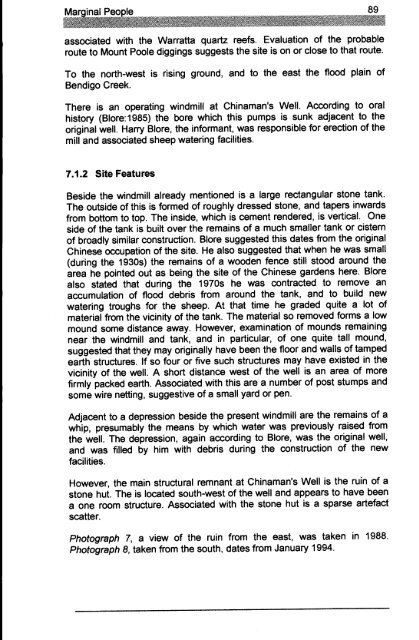Adec Preview Generated PDF File - The Sydney eScholarship ...
Adec Preview Generated PDF File - The Sydney eScholarship ...
Adec Preview Generated PDF File - The Sydney eScholarship ...
You also want an ePaper? Increase the reach of your titles
YUMPU automatically turns print PDFs into web optimized ePapers that Google loves.
associated with the Warratta quartz reefs. Evaluation of the probable<br />
route to Mount Poole diggings suggests the site is on or close to that route.<br />
To the north-west is rising ground, and to the east the flood plain of<br />
Bendigo Creek.<br />
<strong>The</strong>re is an operating windmill at Chinaman's Well. According to oral<br />
history (Blore: 1985) the bore which this pumps is sunk adjacent to the<br />
original well. Harry Blore, the informant, was responsible for erection of the<br />
mill and associated sheep watering facilities.<br />
7.1.2 Site Features<br />
Beside the windmill already mentioned is a large rectangular stone tank.<br />
<strong>The</strong> outside of this is formed of roughly dressed stone, and tapers inwards<br />
from bottom to top. <strong>The</strong> inside, which is cement rendered, is vertical. One<br />
side of the tank is built over the remains of a much smaller tank or cistern<br />
of broadly similar construction. Blore suggested this dates from the original<br />
Chinese occupation of the site. He also suggested that when he was small<br />
(during the 1930s) the remains of a wooden fence still stood around the<br />
area he pointed out as being the site of the Chinese gardens here. Blore<br />
also stated that during the 1970s he was contracted to remove an<br />
accumulation of flood debris from around the tank, and to build new<br />
watering troughs for the sheep. At that time he graded quite a lot of<br />
material from the vicinity of the tank. <strong>The</strong> material so removed forms a low<br />
mound some distance away. However, examination of mounds remaining<br />
near the windmill and tank, and in particular, of one quite tall mound,<br />
suggested that they may originally have been the floor and walls of tamped<br />
earth structures. If so four or five such structures may have existed in the<br />
vicinity of the well. A short distance west of the well is an area of more<br />
firmly packed earth. Associated with this are a number of post stumps and<br />
some wire netting, suggestive of a small yard or pen.<br />
Adjacent to a depression beside the present windmill are the remains of a<br />
whip, presumably the means by which water was previously raised from<br />
the well. <strong>The</strong> depression, again according to Blore, was the original well,<br />
and was filled by him with debris during the construction of the new<br />
facilities.<br />
However, the main structural remnant at Chinaman's Well is the ruin of a<br />
stone hut. <strong>The</strong> is located south-west of the well and appears to have been<br />
a one room structure. Associated with the stone hut is a sparse artefact<br />
scatter.<br />
Photograph 7, a view of the ruin from the east, was taken in 1988.<br />
Photograph 8, taken from the south, dates from January 1994.




